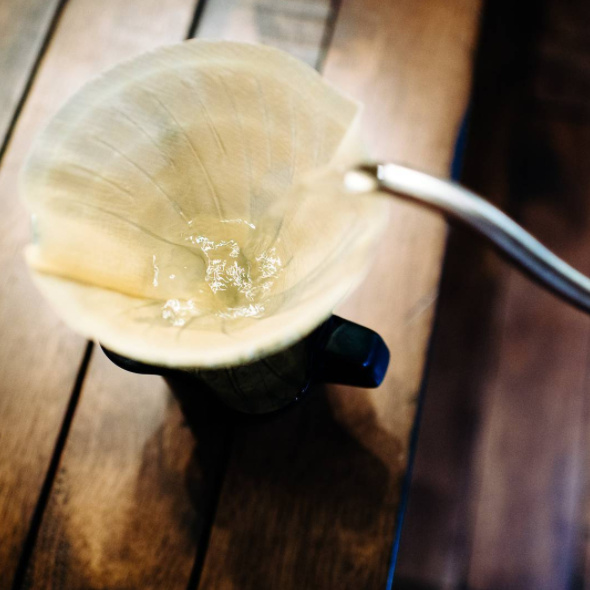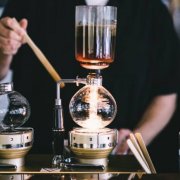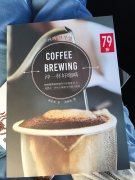The water temperature of brewing coffee determines the extraction efficiency and how to adjust the water temperature according to the taste.

Professional coffee knowledge exchange more coffee bean information please follow the coffee workshop (Wechat official account cafe_style)
Relationship between water temperature of hand-brewed coffee and extraction tools and freshness of coffee beans
'temperature'
Extraction efficiency: like other brewing equipment, temperature affects the extraction efficiency of coffee. Bitter and astringent and so on belong to the flavor of the later stage, if the coffee is too bitter and scorched, you can try to lower the temperature. On the other hand, if you rush out and feel that there are still many flavors left in the coffee grounds, you can consider raising the temperature.
Powder layer development: in the case of fresh beans, another noteworthy place is the development of powder layer. On the side of the temperature, the higher the temperature, the faster the coffee powder expands when the water is washed onto the coffee powder. In the face of shallow baked beans, grinding is relatively fine and the powder layer is not easy to expand, we can consider increasing the water temperature to assist the development of the powder layer.
'Grinding thickness'
Extraction efficiency: the same thickness of hand grinding powder also affects the extraction rate, fine powder extraction rate, large powder coarse extraction rate is small. Hand flushing belongs to constantly adding water and constantly filtering, not as good as syphon immersion. Therefore, the thickness of the powder is much more important to the flow rate and the development of the powder layer.
Powder layer development: usually for fresh coffee beans, the coarse and fine powder layer ground near Taiwan Sugar No.2 Sugar will expand better (of course, this will change depending on the baking degree). Then the thicker the grinding, because the water quickly develops slowly through the powder layer, and the finer the grinding, because the water is not easy to get stuck on the powder and develops slowly. Therefore, the coarse grinding water column and flushing speed can be slowed down to adjust the flow rate, while the relative fine grinding can dig a hole in the powder layer to improve water penetration.
The ratio of coffee to water
Concentration: generally speaking, if you want to increase the concentration of coffee and increase the amount of coffee powder, of course, it is a way to pay attention to the infiltration after the water is washed down. As the amount of powder increases, the powder layer in the filter cup also thickens. It is recommended to circle more water in the middle to facilitate the coffee powder in the middle to receive enough water.
Weight: it is generally recommended that three-hole filter cup 15g flush 150c.c. Coffee, that is not to make 300c.c. It takes 30g and 450c.c. How about 45g? The answer is not that the concentration of hand flushing is related to the flow rate and the time for the water to stay in the coffee powder. Because the more the cup powder, the more the powder, the longer the water stays in the powder layer, the better the extraction efficiency. Relative to the amount of powder, the flow rate of the same boiling water column will cause a slower flow rate. So the more cups you cook, you can reduce the amount of powder and increase the water column.
'baking degree'
Shallow baking: shallow baked beans usually do not bubble well when they are exposed to hot water, and the texture of shallow baked beans is more dense and easy to sink during cooking, resulting in a sparse surface. Similarly, this will affect the flow rate, so it is generally recommended that the shallow baked beans should have a high temperature of more than 90 ℃ and a smaller water column, so that it is easier to flush out the flavor.
Deep baking: the texture of deep-baked beans is much looser, the water absorption is good, the powder layer is easy to expand due to water, and the coffee powder is easy to float on the surface, but the more bitter the taste is, the heavier it is. The advantage of deep roasting beans is that the thickness and coffee oil can be shown at 88m / m / 90 degrees.
Therefore, the recommendations of baking degree and temperature are as follows:
Bake over a shallow heat: the temperature is about 90 murmur93 degrees. After boiling, pour into a copper pot and brew.
Bake moderately to medium heat slightly deep: the temperature is about 80 Murray 85 degrees Celsius
Deep baking: the temperature is about 88m / m / m / 90 degrees
'freshness'
Freshness in addition to the change in the flavor of the coffee itself, there is a significant difference in the foaming of coffee powder caused by hot water expansion. The freshly baked beans bubbled better, while those baked at room temperature for more than two weeks bubbled less well. In the case of bad bubbles, you can consider using a smaller water column to increase the time for the water to stay in the powder so that the flavor can be flushed out. But it is not recommended to drink stale beans.
[adjust the cause according to taste]
"adjust the grinding particles of coffee according to the taste": adjust the water temperature
1. If the coffee tastes scorched, astringent, bitter and stays for a long time, the water temperature is too high.
two。 If the coffee tastes astringent and the smell of grass is heavy as if the coffee is not cooked (brewed through), it means the water temperature is too low.
"adjust according to taste / water temperature unchanged": adjust particle thickness
1. If the coffee tastes scorched, astringent and bitter, it means that the particles are too fine.
two。 If the coffee tastes light and tasteless, it means that the particles are too coarse.
"adjust / bake degree according to taste": adjust water temperature
1. If the coffee beans look bright and oily, and the coffee tastes scorched, you can raise the temperature of the water a little bit.
two。 If the coffee beans look cinnamon (or a little darker), the coffee tastes astringent and the smell of grass is heavy, as if the coffee is undercooked (brewed), you can increase the temperature of the water and lower the temperature.
.
Important Notice :
前街咖啡 FrontStreet Coffee has moved to new addredd:
FrontStreet Coffee Address: 315,Donghua East Road,GuangZhou
Tel:020 38364473
- Prev

Siphon Coffee Brewing Tips Siphon pot best water temperature for brewing coffee
Professional coffee knowledge exchange More coffee bean information Please pay attention to coffee workshop (Weixin Official Accounts cafe_style) The relationship between hand-brewed coffee brewing water temperature and extraction tools and coffee bean freshness 1. Boil in fresh water (be sure to filter) and boil thoroughly. When the coffee powder is soaked in hot water, the temperature of the hot water needs to be around 90 degrees, and then filtered into the coffee pot will change.
- Next

Coffee beginner's books recommend the introduction to the textbook how to brew a good cup of coffee.
Professional coffee knowledge exchange more coffee bean information please follow coffee workshop (Wechat official account cafe_style) Coffee book recommendation | popular science reader Coffee Coffee everywhere I went to the bookstore this weekend to read a lot of coffee books, there are several coffee products, introduce three I buy back think very useful, the first one is practical, the workshop can see 21 kinds of coffee utensils written in
Related
- Beginners will see the "Coffee pull flower" guide!
- What is the difference between ice blog purified milk and ordinary milk coffee?
- Why is the Philippines the largest producer of crops in Liberia?
- For coffee extraction, should the fine powder be retained?
- How does extracted espresso fill pressed powder? How much strength does it take to press the powder?
- How to make jasmine cold extract coffee? Is the jasmine + latte good?
- Will this little toy really make the coffee taste better? How does Lily Drip affect coffee extraction?
- Will the action of slapping the filter cup also affect coffee extraction?
- What's the difference between powder-to-water ratio and powder-to-liquid ratio?
- What is the Ethiopian local species? What does it have to do with Heirloom native species?

